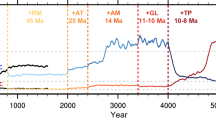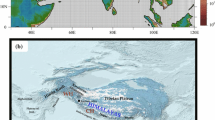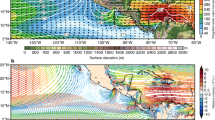Abstract
This study explores the role of the global mountain uplift (MU), which occurred during the middle and late Cenozoic, in modulating global monsoon precipitation using the Meteorological Research Institute atmosphere-ocean coupled model experiments. First, the MU causes changes in the annual mean of major monsoon precipitation. Although the annual mean precipitation over the entire globe remains about the same from the no-mountain experiment (MU0) to the realistic MU (MU1), that over the Asian-Australian monsoon region and Americas increases by about 16% and 9%, respectively. Second, the MU plays an essential role in advancing seasonal march, and summer-monsoon onset, especially in the Northern Hemisphere, by shaping pre-monsoon circulation. The rainy seasons are lengthened as a result of the earlier onset of the summer monsoon since the monsoon retreat is not sensitive to the MU. The East Asian monsoon is a unique consequence of the MU, while other monsoons are attributed primarily to land-sea distribution. Third, the strength of the global monsoon is shown to be substantially affected by the MU. In particular, the second annual cycle (AC) mode of global precipitation (the spring-autumn asymmetry mode) is more sensitive to the progressive MU than the first mode of the AC (the solstice mode), suggesting that the MU may have a greater impact during transition seasons than solstice seasons. Finally, the MU strongly modulates interannual variation in global monsoon precipitation in relation to El Niño and Southern Oscillation (ENSO). The Progressive MU changes not only the spatial distribution but also the periodicity of the first and second AC mode of global precipitation on interannual timescale.
Similar content being viewed by others
References
Abe, M., A. Kitoh, and T. Yasunari, 2003: An evolution of the Asian summer monsoon associated with mountain uplift-simulation with the MRI atmosphere-ocean coupled GCM. J. Meteor. Soc. Japan, 71, 909–933.
Abe, M., T. Yasunari, and A. Kitoh, 2004: Effects of large-scale orography on the coupled atmosphere-ocean system in the tropical Indian and Pacific Oceans in boreal summer. J. Meteor. Soc. Japan, 82, 745–759.
Abe, M., T. Yasunari, and A. Kitoh, 2005: Sensitivity of the central Asian climate to uplift of the Tibetan Plateau in the coupled climate model (MRI-CGCM1). Isl. Arc, 14, 378–388.
Barron, E. J., 1985: Explanations of the tertiary global cooling trend. Palaeogeogr. Palaeocl., 50, 45–61.
Barron, E. J., C. G. A. Harrison, J. L. Sloan III, and W. W. Hay, 1981: 1980 million years ago to the present. Paleogeography, 74, 443–470.
Boos, W. R., and Z. Kuang, 2010: Dominant control of the South Asian monsoon by orographic insulation versus plateau heating. Nature, 463, 218–222.
Broccoli, A. J., and S. Manabe, 1992: The effects of orography on midlatitude North Hemisphere dry climates. J. Climate, 5, 1181–1201.
Chang, C. P., Z. Wang, J. McBride, and C. H. Liu, 2005: AC of Southeast Asia-Maritime continent rainfall and the asymmetric monsoon transition. J. Climate, 18, 287–301.
Hanh, D. G., and S. Manabe, 1975: The role of mountains in the south Asian monsoon circulation. J. Atmos. Soc., 32, 1515–1541.
Jiang D., Z. Ding, H. Drange, and Y. Gao, 2008: Sensitivity of East Asian climate to the progressive uplift and expansion of the Tibetan Plateau under the Mid-Pliocene boundary condition. Adv. Atmos. Sci., 25, 709–722.
Kim, H.-J., and Coauthors, 2011: Global monsoon, El Niño, and their interannual linkage simulated by MIROC5 and the CMIP3 CGCMs. J. Climate, 24, 5604–5618.
Kitoh, A., 1997: Mountain uplift and surface temperature changes. Geophys. Res. Lett., 24, 185–188.
Kitoh, A., 2002: Effects of large-scale mountains on surface climate-a coupled ocean-atmospheric general circulation model study. J. Meteor. Soc. Japan, 80, 1165–1181.
Kitoh, A., 2004: Effects of mountain uplift on East Asian summer climate investigated by a coupled atmosphere-ocean GCM. J. Climate, 17, 783–802.
Kitoh, A., 2007: ENSO modulation by mountain uplift. Clim. Dynam., 28, 781–796.
Kitoh, A., T. Motoi, and O. Arakawa, 2010: Climate modeling study on mountain uplift and Asian monsoon evolution. In: P. D. Clift, R. Tada, and H. Zheng (eds) Monsoon Evolution and Tectonics-Climate Linkage in Asia, 293–301.
Kutzbach, J. E., P. J. Guetter, W. F. Ruddiman, and W. L. Prell, 1989: Sensitivity of climate to late Cenozoic uplift in southern Asia and the American West: Numerical experiment. J. Geophys. Res., 94, 18393–18407.
Lau, K. M., and P. H. Chan, 1983: Short-term climate variability and atmospheric teleconnections from satellite-observed outgoing longwave radiation. Part II: lagged correlations. J. Atmos. Sci., 40, 2751–2767.
Lee, J.-Y., and B. Wang, 2014: Future change of global monsoon in the CMIP5. Clim. Dynam., 42, 101–119.
Lee, J.-Y., B. Wang, K.-H. Seo, J.-S. Kug, Y.-S. Choi, Y. Kosaka, and K.-J. Ha, 2014: Future change of Northern Hemisphere summer tropicalextratropical teleconnection in CMIP5 models. J. Climate, 27, 3643–3664.
Lee, J.-Y., and Coauthors, 2010: How are seasonal prediction skills related to models’ performance on mean state and annual cycle?. Clim. Dynam., 35, 267–283.
Lee, S.-S., J.-Y. Lee, K.-J. Ha, B. Wang, A. Kitoh, Y. Kajikawa, and M. Abe, 2013: Role of Tibetan Plateau on climatological annual variation of mean atmospheric circulation and storm track activity. J. Climate, 26, 5270–5286.
Liu, J., B. Wang, Q. Ding, X. Kuang, W. Soon, and E. Zorita 2009: Centennial variations of the global monsoon precipitation in the last millennium: results from ECHO-G model. J. Climate, 22, 2356–2371.
Liu, J., B. Wang, S.-Y. Yim, J.-Y. Lee, J.-G. Jhun, and K.-J. Ha, 2012: What drives the global summer monsoon over the past millennium?. Clim. Dynam. 39, 1063–1072.
Liu, X., and Z. Y. Yin, 2002: Sensitivity of East Asian monsoon climate to the uplift of the Tibetan Plateau. Palaeogeogr. Palaeocl., 183, 223–245.
Manabe, S., and T. B. Terpstra, 1974: The effects of mountains on the general circulation of the atmosphere as identified by numerical experiments. J. Atmos. Sci., 31, 3–42.
Meehl, G. A., 1987: The annual cycle and interannual variability in the tropical Pacific and Indian Ocean regions. Mon. Wea. Rev., 115, 27–50.
Okajima, H., and S. P. Xie, 2007: Orographic effects on the northwestern Pacific monsoon: role of air-sea interaction. Geophys. Res. Lett., 34, L21708, doi:10.1090/2007GL032206.
Ose, T., 1998: Seasonal change of Asian summer monsoon circulation and its heat source. J. Meteor. Soc. Japan, 76, 1045–1063.
Park, H.-S., S.-P. Xie, and S.-W. Son, 2013: Poleward stationary eddy heat transport by the Tibetan Plateau and equatorward shift of westerlies during Northern winter. J. Atmos. Sci., 70, 3288–3301.
Ruddiman, W. F., and M. E. Raymo, 1988: Northern Hemisphere climate regimes during the past 3 Ma: Possible tectonic connections. Philos. T. R. Soc. Lond. Ser. B, 318, 411–430.
Ruddiman, W. F., and J. E. Kutzbach, 1989: Forcing of late Cenozoic Northern Hemisphere climate by plateau uplift in southern Asia and the American West. J. Geophys. Res., 94, 18409–18427.
Sepulchre, P., G. Ramstein, F. Fluteau, M. Schuster, J. J. Tiercelin, and M. Brunet, 2006: Tectonic uplift and eastern Africa aridification. Science, 313, 1419–1423.
Smith, T. M., and R. W. Reynolds, 2004: Improved extended reconstruction of SST (1854-1997). J. Climate, 17, 2466–2477.
Su, F., X. Duan, D. Chen, Z. Hao, and L. Cuo, 2013: Evaluation of the global climate models in the CMIP5 over the Tibetan Plateau. J. Climate, 26, 3187–3208.
Trenberth, K. E., and D. P. Stepaniak, 2004: The flow of energy through the earth’s climate system. Quart. J. Roy. Meteor. Soc., 130, Part B, 2677–2701.
Trenberth, K. E., D. P. Stepaniak, and J. M. Caron, 2000: The global monsoon as seen through the divergent atmospheric circulation. J. Climate, 13, 3969–3993.
Trenberth, K. E., J. W. Hurrell, and D. P. Stepaniak, 2006: The Asian Monsoon. The Asian monsoon: Global perspectives, Springer, 67–87.
Wang, B., and Q. Ding, 2008: The global monsoon: Major modes of annual variation in tropical precipitation and circulation. Dyn. Atmos. Oceans, 44, 65–183.
Wang, B., H.-J. Kim, K. Kikuchi, and A. Kitoh, 2011: Diagnostic metrics for evaluation of annual and diurnal cycles. Clim. Dynam., 37, 941–955.
Wang, B., J. Liu, H.-J. Kim, P. J. Webster, and S.-Y. Yim, 2012: Recent change of the global monsoon precipitation (1979–2008). Clim. Dynam., 39, 1123–1135.
Webster, P. J., V. O. Magana, T. N. Palmer, J. Shukla, R. A. Tomas, M. Yanai, and T. Yasunari, 1998: Monsoon: processes, predictability, and the prospects for prediction. J. Geophys. Res., 103, 14451–14510.
Wu, G., and Coauthors, 2007: The influence of mechanical and thermal forcing by the Tibetan Plateau on Asian climate. J. Hydrometeor., 8, 770–789.
Xie, P., and P. A. Arkin, 1997: Global precipitation: A 17-year monthly analysis based on gauge observations, satellite estimates, and numerical model outputs. Bull. Amer. Meteor. Soc., 78, 2539–2558.
Yasunari, T., K. Saito, and K. Takata, 2006: Relative roles of large-scale orography and land surface processes in the global hydroclimate. Part I: impacts on monsoon systems and the tropics. J. Hydrometeor., 7, 626–641.
Yukimoto, S., and Coauthors, 2001: The new Meteorological Research Institute coupled GCM (MRI-CGCM2)-model climate and variability. Pap. Meteorol. Geophys., 51, 47–88.
Author information
Authors and Affiliations
Rights and permissions
About this article
Cite this article
Lee, JY., Wang, B., Seo, KH. et al. Effects of mountain uplift on global monsoon precipitation. Asia-Pacific J Atmos Sci 51, 275–290 (2015). https://doi.org/10.1007/s13143-015-0077-2
Received:
Accepted:
Published:
Issue Date:
DOI: https://doi.org/10.1007/s13143-015-0077-2




